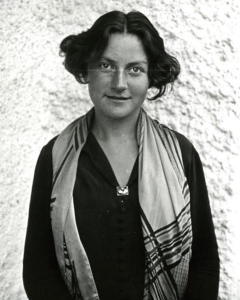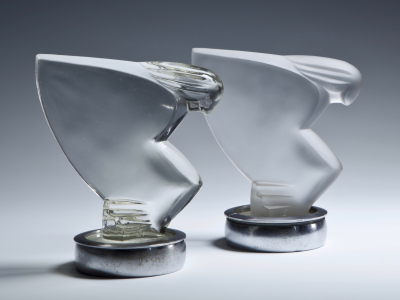

Biography
Lucienne Bloch was born in 1909 in Geneva, Switzerland, the daughter of conductor and photographer Ernest Bloch. The family moved around as Ernest obtained different positions. They came to America in 1917 and moved to Cleveland in 1923, when Ernest was named Music Director at the Cleveland Institute of Music. Lucienne showed an early interest in art, writing and illustrating a children's book when she was 11, but failing to get it published (though she did try). Disgusted with American schools, Ernest pulled Lucienne out of high school, suggesting that she educate herself at home. Instead she enrolled at the Cleveland Institute of Art, becoming their youngest student ever at age 15.
When Ernest was named Director of the Conservatory of Music in San Francisco in 1925, Lucienne's mother declined to accompany him (as per a remarkably explicit account in Lucienne's obituary in the New York Times), and mother and daughter went instead to Europe. Thus Lucienne was able to enroll at the Ecole National et Superieure des Beaux Arts in Paris, studying under the sculptor Antoine Bourdelle and the painter André Lhote.
Lucienne had two life-changing events in 1927, at age 18: she received a Leica from her father, launching a long-term interest in photography; and she saw Fra Angelico's murals in Florence, establishing the basis for a significant career as a muralist. In 1929-1930 Lucienne worked at the Leerdam Glassworks in Holland. This was an industrial glass factory, but Lucienne was able to do glass sculpture, facilitated by the factory's skilled production staff.
In 1931 Lucienne moved back to the United States, expecting to work as a sculptor in New York. She published some of her photographs, and she exhibited her glasswork. But, in a chance encounter, a woman whom she had accompanied as a companion during part of her European stay, invited her to a celebrity banquet. Lucienne was seated next to Diego Rivera, since she knew French, and Diego knew some French, but absolutely no English. The two struck up an amicable conversation, interrupted when Frida Kahlo, finding their exchange a bit too amicable, came up and hissed in Lucienne's ear "I hate you!"
Given the history of Lucienne's womanizing father, Frida's warning was unnecessary, and Lucienne, Frida and Diego eventually became close friends. Meanwhile - and in Bloch's life, there always seemed to be several things going on at once - Frank Lloyd Wright had seen her glassware and heard her ask a sympathetic question at a Wright lecture, so he invited her to join him at Taliesin in Wisconsin. While Lucienne did spend a few months with Wright, she found his overweening ego a bit too much and chose to work with Diego as an apprentice. Thus she was with him in New York in 1931 and 1933, and in Detroit in 1932.
Bloch always had her camera at the ready, so she was able to produce wonderful intimate photographs of Frida and Diego, and she managed to document Rivera's "Man at the Crossroads" mural at Rockefeller Center before its foolish and pointless destruction. Working with Rivera, Bloch met another of his assistants, Stephen Pope Dimitroff. They were married in 1936, and worked together on several frescoes, with Dimitroff typically doing the plastering.
From 1936-1939 Bloch worked for the mural division of the Federal Art Project. She was assigned to produce a "Cycle of a Woman's Life" for the New York House of Detention. Sadly, this work was demolished after the House of Detention was abandoned in 1971. Bloch and Dimitroff did complete a number of other murals, some of which have survived. In particular, they did a mural entitled "The Evolution of Music" for the George Washington High School in New York (1936-1938).
In 1939 Bloch and Dimitroff moved to Flint, MI, where he worked as a union organizer, and she completed several murals. The couple moved to Mill Valley in 1948, where they operated a frame shop. Bloch's post-war projects include a mural for Temple Emanuel in Grand Rapids, MI (1953); an abstract mosaic for the facade of an IBM building in San Jose, CA (1957); a mural for the Calvary Presbyterian Church in San Francisco, CA (1963); mosaics for the Greek Orthodox Church of the Ascension in Oakland, CA (1963-1969, 1977); murals for the First Presbyterian Church in San Rafael, CA (1974); and a mural "The Web of Life" for the College of the Redwoods in Fort Bragg, CA (1987).
Bloch and Dimitroff left Mill Valley in 1965, preferring a more rural environment up the coast in Gualala, CA. She died there in 1999.



Critical Analysis
Lucienne Bloch's one Post Office mural, "General G. H. Thomas and Philip Sheridan," seems to have pleased no one. Townspeople were offended by the theme, and Bloch herself didn't care for the composition. In her oral history with the Archives of American Art, she confessed that she had been too much in the thrall of Diego Rivera when she painted it, and that the resulting heads of Thomas and Sheridan were out of scale for the composition and its location. Photographs of her earlier "Cycle of a Woman's Life" show how well she could handle a looser composition.
In addition to her murals, Bloch made lithographs and woodcuts that are compelling and skillfully executed. Her glass sculptures are lovely. And her photographs show a great eye for composition - with the benefit of her having been on the scene for some important moments in art history. As a result, despite Bloch's obvious ability in many different media, she is probably best remembered for rescuing Rivera's "Man at the Crossroads" from being lost forever. As Bloch noted in her oral history, Rivera did most of his mural composition on the wall as he executed his fresco. There were no cartoons giving a precise indication of how the finished work would look. In fact, Rivera liked to feel rushed as he worked, fearing that otherwise the result would look too polished and artificial. Bloch's photographs captured Rivera's raw images - and enabled him to replicate his work in Mexico City after its destruction in New York.
Murals
- Fort Thomas, Kentucky - Post Office: General G. H. Thomas and Philip Sheridan
- New York, New York - Former George Washington High School: History of Music
References
- Jon Mogul, The Cycle of an Artist's Life, The Wolfsonian March 11 (2011).
- The Early Life of Lucienne Bloch (Lost Art Student). By Kent Judy.
- Lucienne Bloch (Wikipedia).
- Lucienne Bloch (askART).
- Lucienne Bloch (Oxford Reference).
- Laurens Geurtz, Lucienne Bloch - Art Deco in glass, Kunstconsult June 22 (2018).
- Lucienne Bloch (1909–1999), Swiss-american muralist, painter, printmaker, photographer, and educator (www.mural.ch).
- Robert Mcg. Thomas Jr., Lucienne Bloch, Muralist, Is Dead at 90, New York Times March 28 (1999).
- Lucienne Bloch/Old Stage Studios (Lucienne Bloch/Old Stage Studios ).
- OBITUARY -- Stephen Dimitroff, Muralist, Framer, SFGATE September 9 (1996).
- Oral history interview with Lucienne Bloch, 1964 August 11 (Archives of American Art).